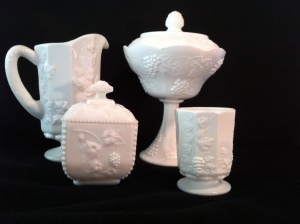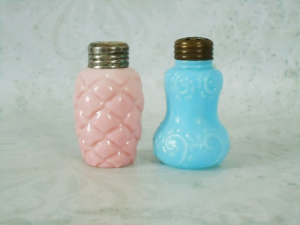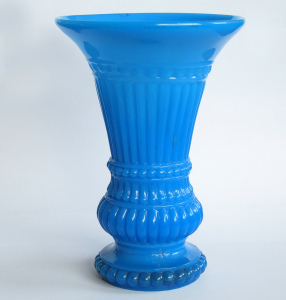Milk Glass – What is It?
Most collectible pieces of milk glass date back to the 1700’s or newer. Did you know, however, that it didn’t receive the popular name until much later, even though its making dates back to 1500’s Venice? Though some people associate milk glass with depression glass, the two are very different, with simply an overlap during production times. In fact, milk glass produced during the Depression is often not as valuable due to cheap production used during the Depression Era. Depression glass pieces, however, are almost always flawed and their values are unaffected. Since milk glass was a luxury item, higher quality pieces managed to maintain and increase in value throughout the centuries.
 Milk Glass in the Popular White Color
Milk Glass in the Popular White Color
Milk glass, as its name would suggest, is a milky colored glass that ranges in colors from blue, pink, black, brown, yellow and white. Though white is the most popular, blue is a close second. Many of the other colors are rare finds due to the popularity of the other colors, even during production. The glass was and still is produced to create vases and other décor items, dishes, perfume bottles and even lanterns. Its similar look to porcelain gives it the elegance sought after by so many, but the cost is often cheaper.
History of Milk Glass
After hundreds of years of being produced around the world, makers of milk glass were mostly in Eastern Pennsylvania by the mid 1800’s. Its popularity peaked in the 1940’s and 1950’s. Pieces manufactured during this time are the most common finds. Collectors, however, may find themselves lucky enough to stumble upon a French piece from the 19th century. Those produced during the Gilded Age are particularly elegant in comparison to pieces made in other times. Generally speaking, the deeper the white color is, the better the quality of the piece is. An exception to this rule is obviously reproductions, as they are not as valuable as the antique pieces.
Fast Facts About Milk Glass:
- While the glass was hot, ash or oxides were added which created the white, milky color.
- Even though the color typically represents quality, there is one exception. Pieces made during the 1880’s were duller in color due to the arsenic that was added to the hot glass. Some of these pieces are particularly valuable.
- During its peak popularity, color was added and new varieties of milk glass became available in pink, blue, green and purple. Westmoreland and Atterbury were common manufacturers during this time.
- The best way to identify milk glass is to become familiar with some of the popular patterns, so you can identify pieces you purchase by the pattern. The pattern will lead you to find its maker and likely its age.
- Milk glass serves as a common, yet beautiful, type of wedding décor. Its white elegance can bring out beautiful colors in flowers and other décor, while remaining understated and classy.
Blue Milk Glass – A Close Second in Popularity
Makers and Markers:
Fenton and Westmoreland were some of the most common producers of milk glass that is valuable to this day. Though not all pieces are marked, it’s quite easy to spot a marker for Fenton. Fenton changed its marker throughout the years and each one is very different from the others. The name, Fenton, however, appears on each marking. A visit to the company’s website (www.fentonartglass.com) will show each marking specifically with its time period, so you can compare it to your milk glass piece to be certain.
Westmoreland can be identified easily by its patterns. Raised clusters of leaves and grapes were common among more than 100 pieces made by the company. Westmoreland also featured birds and flowers on their pieces, and some of these designs were painted. They also marked some of their pieces with a “W” inside a keystone or circle, or a “W” over a “G.” Some have Westmoreland Glass written around the keystone, and others have the letter “W” paired with other text. It’s worth noting that the markings of Westmoreland are placed on contemporary pieces as well, and most Westmoreland milk glass produced between 1920 and 1960 contained no marking.
Collectors’ Tips:
The following tips are very helpful when starting a collection of this type of glass, or for if you simply have a piece or two you’d like to keep for years to come. If you plan on selling some pieces you’ve recently discovered, some of the following tips may be helpful for you as well.
- Some pieces are worth enough to be insured. Be sure to check the values of any of your collectible pieces at least once per year.
- If there is any remaining paint, even if it is damaged or in small amounts, it is best to leave the piece as is. The original character of the piece can continue to appreciate over time.
- Better quality pieces were fire polished. This is a process that reheats the glass after it is pressed, causing it to appear smoother and reveal less marks from the mould.
- Most milk glass was designed to be used as dinnerware, although many patterns are strictly decorative.
- Milk glass does not tolerate temperature changes very well, so one should take care to properly store the items during extreme temperatures. This also means you should never place these items in a dishwasher or in water with an extreme temperature variation.
- Glasses that appear to have a “film” over them cannot be remedied. It is best to avoid these or pieces that are cracked or chipped, as these are unlikely to hold value and are prone to further damage.
- Pieces created after the 1960’s do not retain much value. Pieces made during the 60’s and 70’s are usually paler and of poorer quality.
Today, milk glass is still produced by Fenton Glass Company, Atterbury Glass Company and Fostoria Glass Company. Whether you are looking for a beautiful piece for a wedding or to collect, it is essential to carefully inspect the piece for some of the characteristics described above. Once you become familiar with characteristics, patterns and makers, spotting a great piece of milk glass will come more easily!
 Pink, Turquoise and other Milk Glass Colors Can Also Be Beautiful Choices
Pink, Turquoise and other Milk Glass Colors Can Also Be Beautiful Choices





